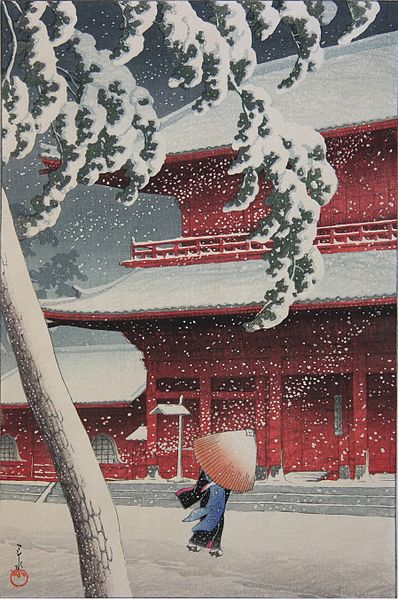Woodblock printing in Japan
Woodblock printing in Japan is a technique best known for its use in the ukiyo-e artistic genre of single sheets, but it was also used for printing books in the same period. Invented in China during the Tang Dynasty, woodblock printing was widely adopted in Japan during the Edo period (1603–1868). It is similar to woodcut in Western printmaking in some regards, but was widely used for text as well as images. The Japanese mokuhanga technique differs in that it uses water-based inks—as opposed to Western woodcut, which typically uses oil-based inks. The Japanese water-based inks provide a wide range of vivid colors, glazes, and transparency.
The Great Wave off Kanagawa (神奈川沖浪裏, Kanagawa-oki nami-ura) print by Hokusai Metropolitan Museum of Art
Saga-bon (嵯峨本, Saga Books): libretto for the Noh play Katsuragi by Hon'ami Kōetsu. The Saga-bon is one of the earliest works produced on a movable type press in Japan.
Ukiyo-e based on kabuki actors became popular. Ichikawa Danjūrō V in the popular kabuki play Shibaraku, by Utagawa Kunimasa, 1796
Zōjō-ji in Shiba. From series Twenty Views of Tōkyō by Hasui Kawase, a shin-hanga artist.
Ukiyo-e is a genre of Japanese art that flourished from the 17th through 19th centuries. Its artists produced woodblock prints and paintings of such subjects as female beauties; kabuki actors and sumo wrestlers; scenes from history and folk tales; travel scenes and landscapes; flora and fauna; and erotica. The term ukiyo-e translates as 'picture[s] of the floating world'.
Tokugawa Ieyasu established his government in the early 17th century in Edo (modern Tokyo).Portrait of Tokugawa Ieyasu, Kanō school painting, Kanō Tan'yū, 17th century
The Hikone screen may be the oldest surviving ukiyo-e work, dating to c. 1624–1644.
Early woodblock print, Hishikawa Moronobu, late 1670s or early 1680s
Standing portrait of a courtesanInk and colour painting on silk, Kaigetsudō Ando, c. 1705–10








